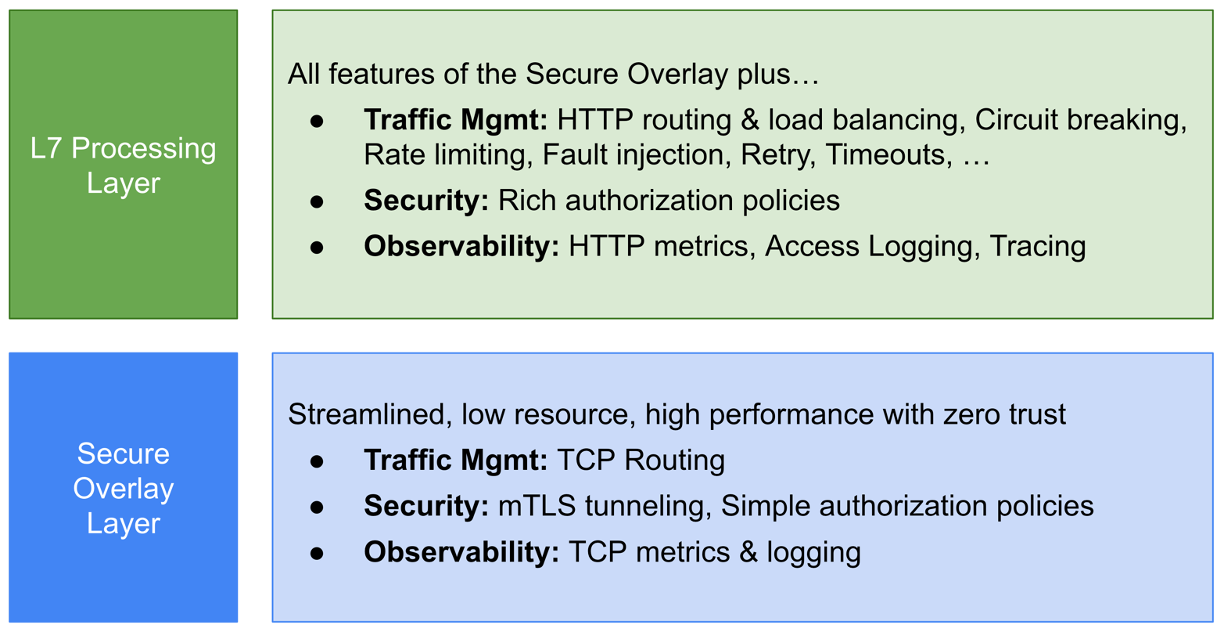Ambient mesh is a new data plane mode for Istio that doesn’t rely on sidecars.
It gives users the option to forgo sidecar proxies in favor of a mesh data plane that’s integrated into your infrastructure.
Ambient mesh benefits are:
- Minimal configuration for traffic encryption.
- Same configuration for L7 policies as ”normal service mesh”.
- Take less resources because no sidecars are needed.
- Easier upgrades because pods don’t need to restart in order to upgrade the service mesh.
- Sidecars might break workloads (I’m looking at you GitLab…)
It also gives the flexibility to opt-in on features of the service mesh according to your needs.

New components
ztunnel
Ztunnel (zero trust tunnel).
Deployed as a daemonset in the form of a pod per node in the cluster, including Kubernetes control-plane nodes.
Istio-CNI uses IPtables Rules to direct traffic into a tunnel (plain text for now).
It handles mTLS different than an Envoy proxy. An Envoy sidecar does a HTTP TLS upgrade, and it will encrypt every packet. A ztunnel encrypts every byte stream that enters into it
Future releases could use eBPF to route traffic to the ztunnel instead of using Iptables
HBONE
HBONE (HTTP Based Overlay Network Environment) protocol to encapsulate traffic inside the ztunnel.
Runs on a dedicated port: 15008
support metadata - ‘baggage’ header, source/destination info
Waypoint proxy
Waypoint proxy, an Envoy proxy that handles layer 7 capabilities, deployed per namespace or per service.
Installation
Kubernetes Kind installation
Installing a 1 control-plane, 2 worker node kind kubernetes cluster
sudo kind create cluster --config=- <<EOF
kind: Cluster
apiVersion: kind.x-k8s.io/v1alpha4
name: ambient
nodes:
- role: control-plane
- role: worker
- role: worker
networking:
apiServerAddress: "192.168.0.198"
apiServerPort: 6443
EOF
Increate the open file limit
sudo sysctl fs.inotify.max_user_watches=524288
sudo sysctl fs.inotify.max_user_instances=512
Set the proper permisions to your kubeconfig
sudo cp /root/.kube/config ~/.kube/config
sudo chown $USER:$USER ~/.kube/config
Istio with Ambient profile
Download istioctl binary from the expermimental branch
wget https://storage.googleapis.com/istio-build/dev/0.0.0-ambient.191fe680b52c1754ee72a06b3e0d3f9d116f2e82/istio-0.0.0-ambient.191fe680b52c1754ee72a06b3e0d3f9d116f2e82-linux-amd64.tar.gz
tar -xvf istio-0.0.0-ambient.191fe680b52c1754ee72a06b3e0d3f9d116f2e82-linux-amd64.tar.gz
Install
cd istio-0.0.0-ambient.191fe680b52c1754ee72a06b3e0d3f9d116f2e82/
./bin/istioctl install -d manifests/ --set profile=ambient -y
Verify
kubectl -n istio-system get pods
NAME READY STATUS RESTARTS AGE
istio-cni-node-b6t7q 1/1 Running 0 54s
istio-cni-node-fblgc 1/1 Running 0 54s
istio-cni-node-z2b8g 1/1 Running 0 55s
istio-ingressgateway-dd667dbb7-stvfg 1/1 Running 0 55s
istiod-6f9c757686-z6hq7 1/1 Running 0 2m5s
ztunnel-25j69 1/1 Running 0 86s
ztunnel-x5lmv 1/1 Running 0 86s
ztunnel-zk2sc 1/1 Running 0 86s
Observability
Ambient Mesh not working properly with current tooling and dashboards
kubectl apply -f ambient/samples/addons/prometheus.yaml
kubectl apply -f ambient/samples/addons/jaeger.yaml
kubectl apply -f ambient/samples/addons/kiali.yaml
kubectl apply -f ambient/samples/addons/grafana.yaml
Demo
Deploy a demo application
mv istio-0.0.0-ambient.191fe680b52c1754ee72a06b3e0d3f9d116f2e82 ambient
kubectl apply -f ambient/samples/helloworld
kubectl apply -f ambient/samples/sleep
Connect to sleep pod
kubectl exec -it sleep-78ff5975c6-s9vbf -- sh
curl helloworld:5000/hello
Adding workloads to the ambient mesh by adding a label to your namesapce
istio.io/dataplane-mode=ambient
kubectl label namespace default istio.io/dataplane-mode=ambient --overwrite=true
kubectl label namespace default istio.io/dataplane-mode= --overwrite=true
Waypoint proxy
apiVersion: gateway.networking.k8s.io/v1alpha2
kind: Gateway
metadata:
name: gateway-helloworld
annotations:
istio.io/service-account: sleep
spec:
gatewayClassName: istio-mesh
kubectl apply -f manifests/waypoint.yml
# kubectl delete -f manifests/waypoint.yml
Waypoint policies
# fault injection
apiVersion: networking.istio.io/v1alpha3
kind: VirtualService
metadata:
name: helloworld
spec:
hosts:
- "helloworld"
http:
- match:
- uri:
exact: /hello
fault:
delay:
percentage:
value: 100.0
fixedDelay: 5s
route:
- destination:
host: helloworld
port:
number: 5000
kubectl apply -f manifests/policies.yml
curl helloworld:5000/hello
# kubectl delete -f manifests/policies.yml
Debug
export TERM=xterm-256color
kubectl debug -it -n istio-system ztunnel-pl97l --image=nicolaka/netshoot
termshark -i eth0 port 5000